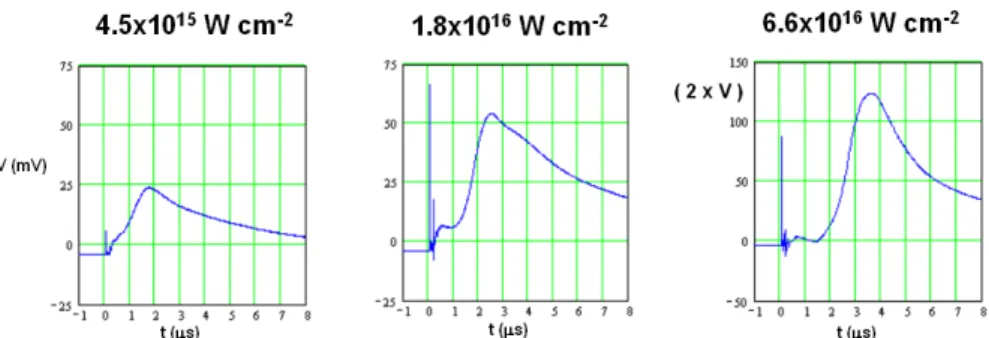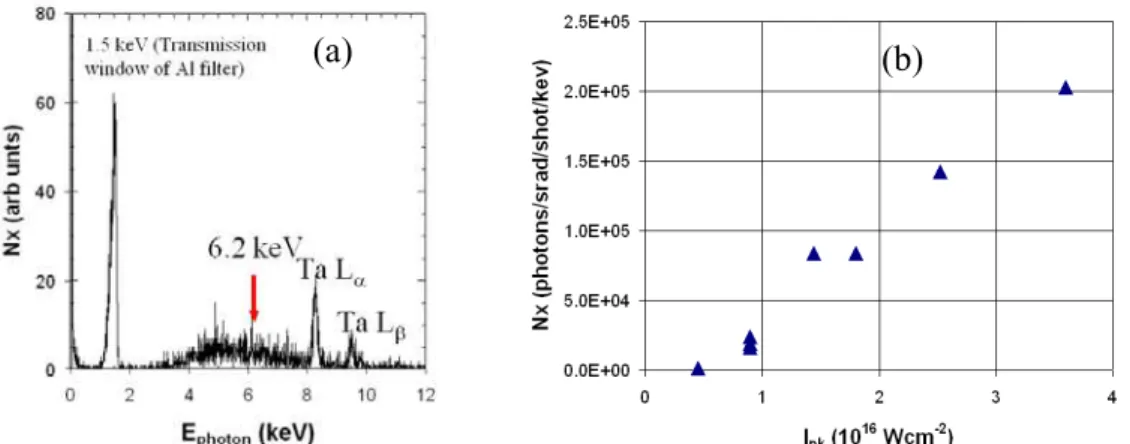HAL Id: in2p3-00102110
http://hal.in2p3.fr/in2p3-00102110
Submitted on 29 Sep 2006HAL is a multi-disciplinary open access
archive for the deposit and dissemination of sci-entific research documents, whether they are pub-lished or not. The documents may come from teaching and research institutions in France or abroad, or from public or private research centers.
L’archive ouverte pluridisciplinaire HAL, est destinée au dépôt et à la diffusion de documents scientifiques de niveau recherche, publiés ou non, émanant des établissements d’enseignement et de recherche français ou étrangers, des laboratoires publics ou privés.
Heating of Tantalum plasma for studies on the
activation of the 6.238 keV nuclear level of Ta-181
R. Fedosejevs, F. Gobet, F. Dorchies, C. Fourment, F. Hannachi, M.M.
Aléonard, G. Claverie, G. Malka, J.N. Scheurer, M. Tarisien, et al.
To cite this version:
R. Fedosejevs, F. Gobet, F. Dorchies, C. Fourment, F. Hannachi, et al.. Heating of Tantalum plasma for studies on the activation of the 6.238 keV nuclear level of Ta-181. C. Hidalgo, B.Ph. van Milligen. 32nd European Physical Society Conference on Plasma Physics and Controlled Fusion combined with the 8th International Workshop on Fast Ignition of Fusion Targets, Jun 2005, Taragona, Spain. Eu-ropean Physical Society, 29C (29C), 4 p., 2005, Europhysics Conference Abstracts. �in2p3-00102110�
Heating of Tantalum Plasma for Studies on the Activation of the
6.238 keV Nuclear Level of Ta-181
R. Fedosejevs1,*, F. Gobet2, F. Dorchies1 , C. Fourment1, F. Hannachi2,M.M. Aléonard2, G. Claverie2, M.Gerbaux2, G. Malka2, J.N. Scheurer2, M. Tarisien2, V. Meot3, P. Morel3, B.
Liesfeld4 , L. Robson5, F. Blasco1, D. Descamps1, G. Schurtz1, Ph. Nicolai1 and V. Tikhonchuk1
1
CELIA, Université Bordeaux 351 cours de la libération, 33405 Talence, France
2
CENBG, IN2P3-Université Bordeaux1, Domaine du Haut-Vigneau, 33170 Gradignan, France
3
CEA/Service de Physique Nucléaire, B.P.12, 91680, Bruyères le Châtel, France
4
IOQ, Friedrich Schiller University, Jena, Germany
5
Dept of Physics, University of Strathclyde Glasgow, G4 0NG, UK
*
on leave from the University of Alberta, Edmonton, AB T6G2V4, Canada
1. Intr oduction
Previous reports1 have indicated that the activation and decay of the 6.238 keV nuclear level of 181Ta can be enhanced significantly in femtosecond laser heated tantalum plasmas by electron and X-ray excitation. In the current experiment such enhancement has not been observed thus far2 and a detailed understanding of the plasma conditions is required to understand the results obtained.
Experiments were carried out using 45 fs Ti:sapphire laser pulses focused with a 20 cm lens to intensities of 0.5 - 8 x 1016 Wcm-2 in a 10 om spot (1/e intensity diameter), at 45o p-polarized on rotating tantalum targets. The measured prepulse contrast ratio was 6x10-5 for a 45 fs pulse 4 ns prior to the main pulse. Target shots were taken at a 50 om spacing with six revolutions on one target track and a 50"om spacing between tracks. Measurements were carried out of the ion emission using Langmuir probes (LP), biased at –76V to be in the ion saturation regime, and Rutherford Backscattering from ions collected on a plastic collector foil and of X-ray emission using both CCD and NaI(Tl) pulse height detection systems.
2. Expected Plasma Scaling
At intensities around 1016 Wcm-2 the interaction of femtosecond pulses with solid surfaces is dominated by resonance absorption3,4 and the propagation of a nonlinear heat wave at solid
denstiy5,6 into the target. At intensities above ~4x1016 W.cm-2 it is expected that vacuum heating will become an important mechanism4,7. Although absorption was not measured in the present experiment, it can be expected to be on the order of 50% from resonance absorption as measured in other experiments at comparable intensities8. Resonance absorption leads to the generation of hot electrons with an expected hot electron temperature of around 9.6 keV at 1016 Wcm-2 scaling with the 1/3 power of intensity3 assuming a cold electron temperature of 500 eV. A nonlinear heat wave will propagate into the target to a depth of zf ~ 19 to 89 nm with a temperature of Te ~ 246 to 845 eV for absorbed intensities of
0.25 – 4.0x1016 Wcm-2 respectively for 50 fs pulses assuming an average Z=20 and correcting the heat capacity to include the ionization energy. A rarefaction wave propagating at the ion acoustic velocity leads to cooling to the depth of the heat front on a time scale of 370 to 940 fs respectively for the same intensities. Thus the cooling time of the plasma is approximately 500 fs. The expected equilibrium ionization states can be calculated from either a Thomas Fermi model9 or a Collisional Radiative (CR) model10 which are in reasonable agreement. However, the short interaction time does not allow for equilibrium ionization to be achieved and a time dependent calculation based on the CR model10 considering the uppermost 6 ionization levels leads to predicted ionization in 50fs to 1ps time durations almost two times lower than the equilibrium values at electron densities of ne = 1023 cm-3 and Te ~ 300 eV.
Calculations with 10 times enhanced ionization rates to account for autoionization processes11 only increases the ionization by about 6. Overall, for the expected temperature range of 200 - 400 eV the ionization charge state is expected to be around Z ~ 20.
3. Exper imental Results and Discussion
The Langmuir probe signals measured at 13o to target normal are shown in Fig. 1. A small leading peak and a larger following peak are observed with velocities of 1.2 – 1.5x105 m s-1 and 4.9 – 2.8x104 m s-1 for intensities of 0.45 - 6.6 x1016 Wcm-2 respectively. Assuming
Fig 1. Langmuir probe signals at three different intensities into a 50Y load. The probe has a 6mm diameter collection surface at a distance of 9.5 cm from the target.
Z = 20 and 10 respectively for the fast and slow peaks, a ratio of specific heats of i=5/3 and full return of 3-body recombination energy to the expanding plasma the estimated plasma temperatures corresponding12,13 to these velocities are 213 – 330 eV for the first peak and 66 – 21 eV for the second peak. It is expected that the first peak corresponds to the nonlinear heat wave while the second corresponds to solid target material heated by fast electrons and X-rays. Above 2x1016 Wcm-2 the nonlinear heat wave remains approximately constant while more energy is diverted into hot particles and X-ray emission. The higher particle energies lead to deeper heating of a larger volume resulting in a colder temperature as the intensity is increased. The angularly resolved and integrated Ta flux measured by collection on a Mylar foil with subsequent Rutherford Backscatter analysis using 2.3 MeV He+ions is shown in Fig. 2. The integrated flux from the Langmuir probes assuming Z~10 is also shown in Fig. 2. The angular distribution of the Langmuir probe signals was found to fit a cosn(s) distribution with n ~ 6.3‒1. The integrated ion flux from the Langmuir probe is less than the total flux observed on the collector foil as expected since much of the material ablation occurs in the
Fig 2. (a) Angular distribution of deposited Ta measured by RBS measurements and (b) total integrated Ta yield from RBS (squares) and from LP measurements (diamonds).
form of neutral particles and shock heated molten material. Measurements of the X-ray spectrum and emission yield at 6.2 keV photon energy using the X-ray CCD camera are shown in Fig. 3. It is seen that the maximum yield at 6.2 keV is equivalent to the emission of a black body at a temperature of ~285 eV for 0.5 ps from a 10 om diameter spot. Measurements made with the NaI(Tl) detector indicate the appearance of an X-ray tail to several hundred keV for Ipk > 2x1016 Wcm-2 corresponding to the generation of superhot
electrons. In separate measurements using the Langmuir probe to detect ions from the preplasma alone it was determined that a peak intensity of 2x1016 Wcm-2 is the approximate
Fig 3. Measurements of X-ray yield at 6.2 keV from X-ray CCD camera: (a) raw pulse height spectrum through an aluminum foil filter and (b) calculated yield of photons at 6.2 keV threshold for onset of preplasma from the 45 fs prepulse. It is not clear at this point whether the appearance of the super hot electrons is related to the preplasma or to a change in interaction mechanisms such as to vacuum heating.
4. Conclusions
It appears that the short heating time leads to low plasma temperatures and low emission intensities of 6.2 keV radiation which are required for alteration of the nuclear excitation of
181
Ta. Formation of a preplasma and changes in the dominant interaction mechanism also effect the results above 2x1016 Wcm-2 leading to the observation of much more energetic X-ray emission and deeper heating of the bulk target by energetic electrons and X-X-rays. Further measurements and more detailed modeling are required to clarify these issues.
Refer ences:
1. A.V. Andreev et al., JETP 91, 1163-1175 (2000)
2. M.M. Aleonard et al., 7th AFSOR Workshop on Isomers and Quantum Nucleonics, June 26-July 1,2005, Dubna, Russia
3. D.W. Forslund et al., Phys. Rev. Lett. 39, 284 (1977) 4. K. Eidmann et al., Phys. Rev. E 62, 1202 (2000)
5. Ya. B. Zeldovich and Yu. P.Raiser, “Physics of Shock Waves and High Temperature Phenomena”, Academic Press, New York, 1966.
6. R. Fedosejevs et al., Appl. Phys. B 50, 79 (1990)
7. P.Gibbons and E. Förster, Plasma Phys. Control. Fusion 38, 769 (1996) 8. K. Eidmann et al., Europhysics Lett. 55, 334 (2001)
9. R. More, Advances in Atomic and Molecular Physics, 21, 305 (1985) 10. D. Columbant and G.F. Tonon, J. Appl. Phys. 44, 3524 (1973) 11. D.C. Gregory and D.H. Crandall, Phys. Rev. A 27, 2338 (1983) 12. Yu.A. Bykovskii et al., Sov. Phys. JETP 43, 706 (1971)
13. Y.Y.Tsui et al., Phys. Fluids B 5, 3357 (1993)
(a) (b)

